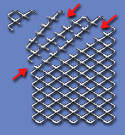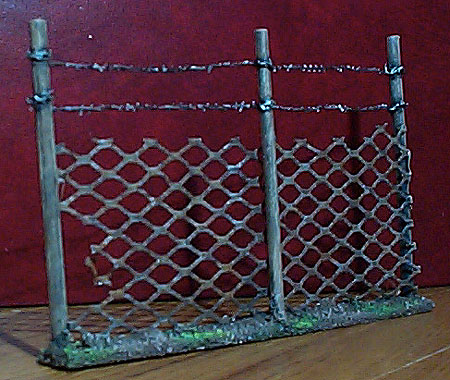|
|
©1999-2003. All rights reserved. |
Fence with Barbed Wire
Fences like these can be used in almost any game from 20th century historical periods to Warhammer 40,000 and cyberpunk settings. They make an interesting terrain feature because they block movement yet provide no cover. At smaller scales net curtain material
could be used, but at this size it would be a bit floppy, as the stiffness
of the mesh helps support the fence posts.
Materials
Barbed Wire
Cutting the Mesh | |||
| Take a large piece of mesh and clip off the very corner. Next cut diagonally along the next row of mesh, but don't cut the last strand. Now cut the next row, but from the opposite end, and repeat this process until you have one long zig-zagging piece. This can then be carefully bent straight. |  |
Reinforcing the Wire
The length of wire that you have made will look good, but the mesh is
very weak and will tear easily. To get something you can use in long
strands, you will need to strengthen it.
Take a piece of fuse wire and strip off the insulation. This can be
done by using a scalpel to pare off all or most of the plastic in a
strip down one side (take care not to cut too deep or you will damage
the wire). You can then take hold of the wire and rip it through the
thin layer of plastic remaining.
Now separate off a single strand of fuse wire (about 50% longer than the lehgth you want the finished strand of barbed wire to be), and twist it together with the strip of mesh.As you do this, make sure the strip of mesh itself is being twisted, so that the 'barbs' stick out in all direction, rather than all being lined up. Each time you get to a joint in the mesh-wire, wrap the fuse wire in a tight coil round this point to reinforce it as these are particular weak points.
Main Fence

Attach mesh to base
Cut a strip of mounting board about 15mm wide to form the base.
If your mesh is very solid, as it was in this example, you may find it easiest to stick this on first and then stick the posts to the mesh. I used a glue gun for this, and once the mesh was stuck to the board, I ran along both sides of it again with the glue gun to get a really strong joint.
Attach posts
Next cut 3" lengths from the bamboo skewers and glue them with
the glue gun to the base and to the mesh. An alternative to the bamboo
skewers would be balsa wood, but this is a little weak - the bits at
the top supporting the barbed wire will be prone to being snapped off.
To attach the barbed wire, it is best to actually wrap it around the skewers and then add a drop of superglue or PVA.
Apply texture to base
Finally apply your standard basing technique to the mounting board.
I use sand on PVA.
Painting

Mesh & Barbed Wire
The mesh I used in the example was already a pleasing rusty texture,
so I just drybrushed with a little gunmetal. If you are using a bright
metal mesh, it is best to paint it black and then drybrush with gunmetal/silver.
To finish off apply a couple of patchy brown and chestnut washes to
give it a weathered and grimy look.
Posts
To get a wood effect on these posts follow the process described for
this crate.


